
 |
Search | FAQ | US Titles | UK Titles | Memories | VaporWare | Digest | |||||||
| GuestBook | Classified | Chat | Products | Featured | Technical | Museum | ||||||||
| Downloads | Production | Fanfares | Music | Misc | Related | Contact | ||||||||
| Featured CED VideoDisc No. 23 - Winter 2002 | ||||||||||||||
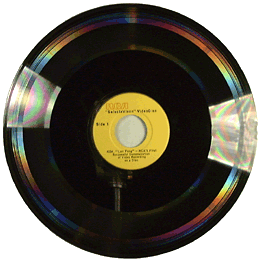
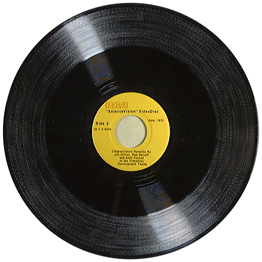
This CED feature is about a disc that could be considered the most unusual CED ever made. In fact, it's one of the most unusual examples of recorded media, being a single piece of vinyl with a playable CED molded on one side and an Audio LP molded on the other side. The disc is titled "Lum Fong," deriving this name from a laundry (and a character) in a Get Smart TV series episode contained on the CED side of the disc. The CED side of "Lum Fong" is officially titled RCA Experimental VideoDisc # 234, and was considered by the engineering staff to be the first successful demonstration of color video recording on a disc. VideoDisc # 234 was first pressed in Princeton, NJ in September 1972 and was demonstrated with great excitement to the entire RCA Laboratories' community at their monthly colloquium session.
Side 2 of "Lum Fong" is a conventional 33 1/3 RPM audio long-playing record. This was recorded in June 1973 when RCA got the idea of producing this commemorative CED for distribution among the engineering staff. The audio LP is 7.5 minutes long and contains congratulatory remarks from Jim Hillier, Bob Sarnoff, and Andy Conrad, the senior RCA management above the VideoDisc project. The audio portion has been converted to a QuickTime audio file and may be listened to in its entirety by clicking HERE.
This disc came out not that long after RCA's first disc pressings in 1970, and thus is a metallized disc with the vinyl substrate being coated with evaporated aluminum followed by a dielectric layer of transparent styrene. This gives the CED a silver surface similar in appearance to a LaserDisc, but more mirror-like, a characteristic that a still photo cannot do justice to. Aluminum produced a somewhat grainy image, so RCA also experimented with evaporated gold (expensive) and copper (could corrode) before developing a copper-iconel bimetal sandwich coating in 1975. Surviving examples of these discs are cool looking, as they have a shiny gold, copper, or silver surface depending on the metallic coating that was used. The need for the conductive and dielectric layers was eliminated in 1977 with the development of the carbonized conductive disc.
The "Lum Fong" disc was mastered when CED's had 4000 grooves per inch and a 10 minute play time on one side. RCA's February player is capable of playing this disc, but it's unknown whether a working February player still exists. This machine used the rather fragile sapphire stylus, which could suddenly break after only a few disc plays. The exact portion of the "Tale of Two Tails" Get Smart episode contained on the disc is likewise unknown. But I would guess, after watching this episode on a recent TV Land broadcast, that it contains the initial scene in the hair salon as well as the scene in the Lum Fong laundry. The reminder of this CED feature provides information on the audio presenters on "Lum Fong," as well as some still images related to the disc.
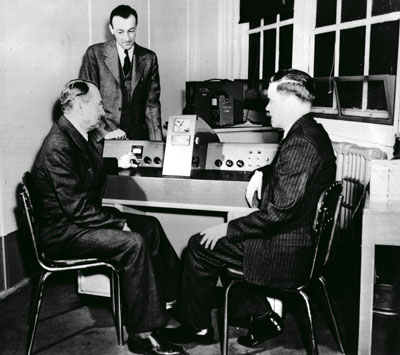
|
At the time "Lum Fong" was made, James Hillier, PhD was head of Research and Engineering at RCA Laboratories, but he is best known for being the co-inventor of the first practical Electron Microscope in 1938 at the University of Toronto. In 1940 he was hired by television pioneer Dr. Vladimir Zworykin at RCA to make the commercial version of the invention whose control panel is shown here in 1943. Dr. Zworykin is seated at the left and Dr. Hillier at the right with RCA Victor design engineer Perry Smith standing behind the instrument. The original EM could magnify about 9,000 times, while this model was capable of 100,000x, and modern electron microscopes can magnify over 2 million times. Dr. Hillier's work with the electron microscope made him a firm believer in using electron beams to accomplish things, so this was the preferred research paradigm when the CED system was under development. RCA continued work on electron-beam recording (EBR) until late 1976, when higher quality masters at lower cost prompted the switch to electromechanical (EM) recording. |
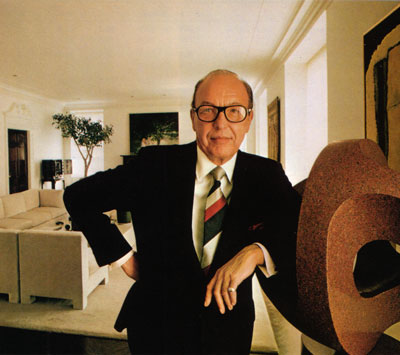
|
Robert W. Sarnoff, was the son of long-term RCA head David Sarnoff, and in 1973 he was Chairman and CEO of the corporation, having succeeded his father in 1968. Despite failing health, David Sarnoff continued to have some influence until his death on December 11, 1971. Before joining RCA, Bob Sarnoff had worked at NBC and was the coordinator for Victory at Sea (partially available on CED) before eventually reaching the presidency at NBC. During his tenure at RCA, Robert Sarnoff is perhaps best remembered for his diversification of RCA into other business ventures with the acquisition of Random House (books), Hertz (rental cars), Banquet (frozen foods), Cushman & Wakefield (real-estate brokers), and Coronet (carpeting). These acquisitions were not without controversy, as RCA was in danger of making the sum of its parts worth more than the whole, and thus ripe for takeover. In one memorable outburst at a shareholder's meeting in 1971 presided over by Bob Sarnoff, a little old lady in a fur bonnet exclaimed: "We have already gone from soup to nuts. Tell me mister, where is it going to end? You are going to build an empire, and look what happened to all the empires!" These indeed turned out to be prophetic words, as RCA was eventually acquired by GE in 1986, but Bob Sarnoff was long gone at that time, having been ousted by the board of directors on November 5, 1975. His successor was Anthony Conrad. Although many blame Bob Sarnoff for the eventual failure of RCA, I don't think that's fair as the Board of Directors approved the proposed merger announced on December 12, 1985. At a special shareholders meeting on February 13, 1986, the merger was approved by 92 percent of the shareholders present, with 63 percent of the holders of voting shares also approving the merger. But it turned out to be anything but a merger, with GE ripping RCA apart to the extent that the name is just a trademark today. If those involved could have forseen what would happen, the alternate strategy for RCA to buy MCA probably would have been pursued and the corporation might be around today. After his ouster from RCA, Bob Sarnoff went into semi-retirement and passed away on February 22, 1997 at the age of 78. |
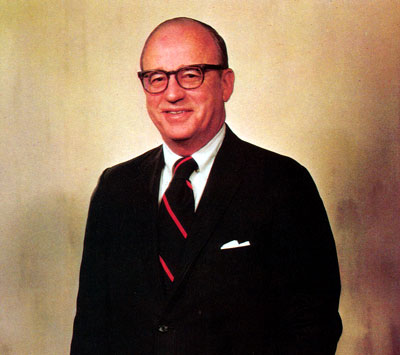
|
Anthony L. Conrad was President of RCA in 1973 and became both President and CEO at the end of 1975 following the ouster of Robert Sarnoff. On June 2, 1976 the RCA Board of Directors appointed Conrad to the position of Chairman as well. At a meeting of RCA shareholders in August 1976, Conrad stated that VideoDisc introduction would take place in 1978, contingent on expected technical progress. RCA operated smoothly under Anthony Conrad until September 13, 1976 when he called a special meeting of the Board of Directors. At that meeting, Conrad revealed that he had not filed any personal federal income tax forms since 1971. Although he wanted to temporarily step aside while the matter was resolved, the Board pressed for formal resignation, which was announced after the meeting. Edgar Griffiths was chosen as Andy Conrad's successor, and it was he who eventually made the decision to introduce CED to the market. Anthony Conrad's failure to file tax forms for five years remains somewhat of a mystery to the present day. The federal government already had withholdings on his then $300,000 a year salary for each of the five years, so there was no financial gain in not filing the forms, and no criminal intent was ever suggested. It is speculated that he simply procrastinated about doing taxes. After leaving RCA, Anthony Conrad dropped out of the public eye, and passed away on January 9, 1984 at the age of 62. |
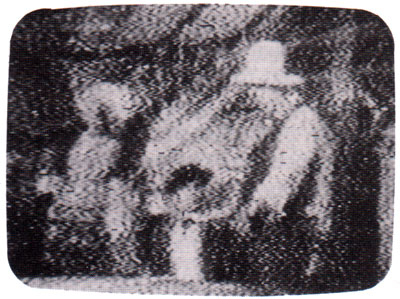
|
CED Quality in 1970
This image was published by RCA to show the image quality possible with electromechanical (EM) recording in October 1970. Although RCA was primarily focused on electron-beam recording (EBR), the first EBR recorder was not completed until April 1971, so EM recording was used for the initial masters. These initial discs were monochrome, and as can be seen, of very low image quality. This image is from the popular NBC television series Bonanza, and the one thing that is readily recognizable in it is the large white top hat worn by Hoss Cartwright. |
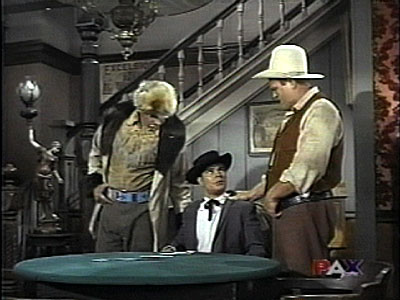
|
Hoss Cartwright in Saloon
The same image as the above rendition from a VideoDisc, but in this instance it was captured from a PAX TV broadcast of the Bonanza episode "Half A Rogue." This show originally aired during the 4th season on January 27, 1963, and is episode no. 118 in the series. At the time of this writing, PAX is airing this TV series, so you may be able to catch this episode by periodically checking their show schedule. In this scene Jim Leyton (Slim Pickens) and Hoss Cartwright (Dan Blocker) are talking to Cal Stacy (John Milford, seated) in a saloon in Virginia City. Slim Pickens is best remembered as the nuclear bomb riding Air Force Major Kong in the CED title Dr. Strangelove, a movie released nearly one year to the day after this Bonanza episode. |
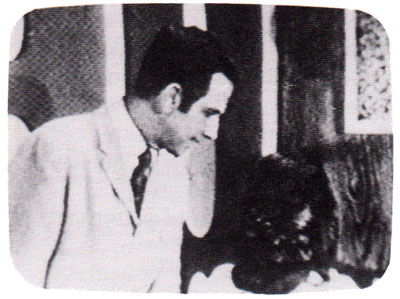
|
CED Quality in 1971
This is a monochrome image from an early disc produced by RCA's electron-beam recorder, which became operational in April 1971. By late 1971 this recorder was capable of producing masters containing color recordings, as is the case with Disc # 234. At this time electron-beam recording (EBR) was of better quality than electromechanical (EM) recording. For the political reasons stated earlier on this page, RCA was mainly focused on EBR until late 1976, although limited research and improvement to EM recording continued. Ultimately RCA had to abandon EBR since it was not possible to consistently produce quality masters via the technique. The research of Jerome Halter proved that high quality masters could be made by EM recording, and the EM mastering equipment was simpler in design than the electron-beam recorder. This image is from the "Tale of Two Tails" episode of the Get Smart television series where Agent 86 (Maxwell Smart) is looking for Agent 99 in a hair salon. |
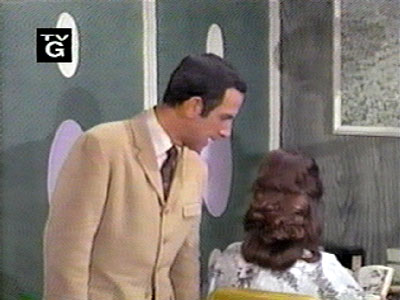
|
Agent 86 in Hair Salon
The same image as the above rendition from a VideoDisc, but in this instance it was captured from a TV Land broadcast of the episode "A Tale of Two Tails." This show originally aired during the 4th season on November 2, 1968, and is episode no. 93 in the series. At the time of this writing, TV Land is airing this TV series in episode order, so you should be able to catch episode 093 by periodically checking their show schedule. |
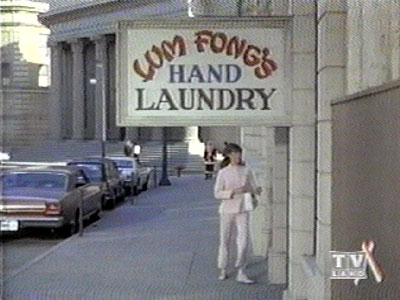
|
Lum Fong Laundry
This image shows where the VideoDisc title "Lum Fong" originates, as that is the name of the laundry where the key scene on the disc takes place, as well as the name of the owner of the laundry. In this scene Agent 99 (Barbera Feldon) is entering the laundry, while Agent 86 (Don Adams) can be seen in the far background wearing a Santa Claus suit. |
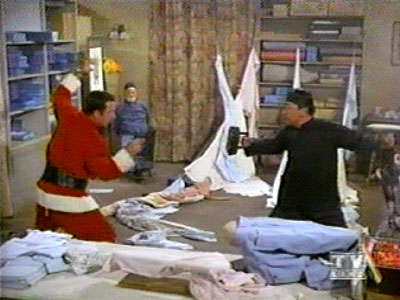
|
Agent 86 battles CHAOS Agent
Here Agent 86 battles a CHAOS agent posing as Lum Fong with a clothes iron. The real Lum Fong can be seen tied up in the background. |
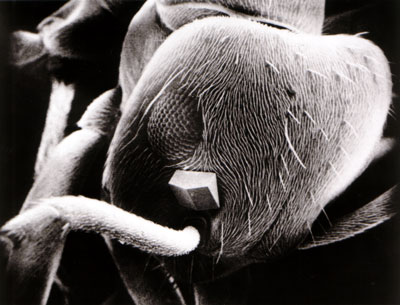
|
EM Cutterhead Stuck in Ant's Head
This is a publicity photo released by RCA showing the wedge-shaped cutterhead diamond stuck into the head of a small house ant between the ant's antenna and eye. This was done to show how small the diamond is, and RCA may have chosen an ant because they could be readily found around the labs, and cutterhead sort of rhymes with ant head. This micrograph was made with a scanning electron microscope after RCA had chosen electromechanical recording over electron-beam recording, so an insider reason for the photo may have been to show an electron beam can make a great photo, even if it isn't as good as an EM cutterhead for mastering VideoDiscs. |